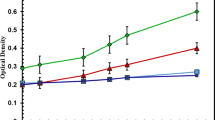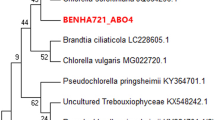Abstract
Bioremediation of wastewater is gaining popularity over chemical treatment due to the greener aspect. The volume of literature containing algal biodegradation is small. Especially, removal of toxic materials like phenol from coke-oven wastewater using fast-growing cyanobacteria was not tried. The current study, therefore, targeted at bioremediation of phenol from wastewater using Leptolyngbya sp., a cyanobacterial strain, as a finishing step. Furthermore, the growth of the strain was studied under different conditions, varying phenol concentration 50–150 mg/L, pH 5–11, inoculum size 2–10% to assess its ability to produce lipid. The strain was initially grown in BG-11 as a reference medium and later in phenolic solution. The strain was found to sustain 150 mg/L concentration of phenol. SEM study had shown the clear difference in the structure of cyanobacterial strain when grown in pure BG-11 medium and phenolic solution. Maximum removal of phenol (98.5 ± 0.14%) was achieved with an initial concentration 100 mg/L, 5% inoculum size at pH 11, while the maximum amount of dry biomass (0.38 ± 0.02 g/L) was obtained at pH 7, initial phenol concentration of 50 mg/L, and 5% inoculum size. Highest lipid yield was achieved at pH 11, initial phenol concentration of 100 mg/L, and 5% inoculum size. Coke-oven wastewater collected from secondary clarifier of effluent treatment plant was also treated with the said strain and the removal of different pollutants was observed. The study suggests the utilization of such potential cyanobacterial strain in treating industrial effluent containing phenol.





Similar content being viewed by others
References
Abdel RN, Homaidan Al AA, Ibraheem IBM (2012) Microalgae and wastewater treatment. Saudi J Biol Sci 19:257–275. https://doi.org/10.1016/j.sjbs.2012.04.005
Banat FA, Bashir Al B, Asheh Al S, Hayajneh O (2000) Adsorption of phenol by bentonite. Environ Pollu 107:391–398. https://doi.org/10.1016/S0269-7491(99)00173-6
Bligh EG, Dyer WM (1959) A rapid method of total lipid extraction and purification. Can J Biochem Physiol 37:911–917
Bohdziewicz J, Kaminski G, Tytła M (2012) The Removal of Phenols from wastewater through sorption on activated carbon. Arch Civil Eng Environ 2:89–94
Clesceri LS, Greenberg AE, Trussell RR (1996) Standard methods for the examination of water and wastewater. APHA, AWWA, WPCF, Washington DC
Dakhil IH (2013) Removal of phenol from industrial wastewater using sawdust. Inter J Eng Sci 3:25–31
Environmental standards. http://scclmines.com/env/Linkfile2.htm Accessed 08 June 2017
Gao L, Li S, Wang Y, Sun H (2015) Organic pollution removal from coke plant wastewater using coking coal. Water Sci Technol 72:158–163. https://doi.org/10.2166/wst.2015.197
Ghasemi Y, Rasoulamini S, Naseri AT, Montazerinajafabady N, Mobasher MA, Dabbagh F (2012) Microalgae biofuel potentials (review). Appl Biochem Microbiol 48:126–144. https://doi.org/10.1134/S0003683812020068
Ghose MK (2002) Physico-chemical treatment of coke plant effluents for control of water pollution in India. Ind J Chem Technol 9:54–59
Hangchang S (2009) Point sources of pollution: local effects and its control. Qian Yi, EOLSS, Oxford
Issa OM, Defarge C, Bissonnais YL et al (2007) Effects of the inoculation of cyanobacteria on the microstructure and the structural stability of a tropical soil. Plant Soil 290:209–219. https://doi.org/10.1007/s11104-006-9153-9
Jain AK, Gupta VK, Jain S, Suhas (2004) Removal of chlorophenols using industrial wastes. Environ Sci Technol 38:1195–1200. https://doi.org/10.1021/es034412u
Karn SK, Chakrabarti S (2015) Simultaneous biodegradation of organic (chlorophenols) and inorganic compounds from secondary sludge of pulp and paper mill by Eisenia fetida. Int J Recycl Org Waste Agricult 4:53–62. https://doi.org/10.1007/s40093-015-0085-3
Kulkarni SJ, Kaware JP (2013) Review on research for removal of phenol from wastewater. Int J Sci Res Publ 3:1–5
Kundu N, Pal M, Saha S (2007) East Kolkata Wetlands: a resource recovery system through productive activities. In: Proceedings of Taal: the 12th world lake conference, pp 868–881
Liu Z, Wenyu X, Dehao L, Yang P, Zesheng L, Shusi L (2016) Biodegradation of Phenol by Bacteria Strain Acinetobacter calcoaceticus PA Isolated from Phenolic Wastewater, Int J Environ Res Public Health 13:300–308. https://doi.org/10.3390/ijerph13030300
Mahiudddin Md, Fakhruddin AN, Abdullah Al M (2012) Degradation of phenol via meta-cleavage pathway by Pseudomonas fluorescens PU1. ISRN Microb 741820:1–6. https://doi.org/10.5402/2012/741820
Michałowicz J, Duda W (2007) Phenols—sources and toxicity. Pol J Environ Stud 16:347–362
Phenol ambient water quality criteria. Office of the planning and standards Environmental Protection Agency (1979), EPA, Washington, DC. https://nepis.epa.gov. Accessed 08 June 2017
Pinto G, Pollio A, Previtera L, Temussi F (2002) Biodegradation of phenols by microalgae. Biotechnol Lett 24:2047–2051. https://doi.org/10.1023/A:1021367304315
Pollio A, Pinto G, Ligrone R, Giovanni A (1993) Effects of the potential allelochemical α-asarone on growth, physiology and ultrastructure of two unicellular green algae. J Appl Phycol 5:395–403. https://doi.org/10.1007/BF02182732
Raychaudhuri S, Mishra M, Nandy P, Thakur A (2008) Waste management: a case study of ongoing traditional practices at East Calcutta. Am J Agri and Biol Sci 3:315–320. https://doi.org/10.3844/ajabssp2008.315.320
Sadhu K, Mukherjee A, Shukla Kr S, Adhikari K, Dutta S (2013) Adsorptive removal of phenol from coke-oven wastewater using Gondwana shale, India: experiment, modeling and optimization. Desalination Water Treat 52:6492–6504. https://doi.org/10.1080/19443994.2013.815581
Semple KT, Cain RB (1996) Biodegradation of phenols by the alga Ochromonas danica. Appl Environ Microbiol 62:1265–1273. (0099-2240/96/$04.0010)
Sezos TM, Remoundaki E, Hatzikioseyian A (2007) Workshop on clean production and nano technologies. Seoul, Korea
Subashchandrabose SR, Ramakrishnan B, Megharaj M, Venkateswarlu K, Naidu R (2013) Mixotrophic cyanobacteria and microalgae as distinctive biological agents for organic pollutant degradation. Environ Int 51:59–72. https://doi.org/10.1016/j.envint.2012.10.007
Tian M, Du D, Zhou W, Zeng X, Cheng G (2017) Phenol degradation and genotypic analysis of dioxygenase genes in bacteria isolated from sediments. Braz J Microbiol 48:305–313. https://doi.org/10.1016/j.bjm.2016.12.002
Ullrich WR, Rigano C, Fuggi A, Aparicio PJ (Eds) (1990) Inorganic nitrogen in plants and microorganisms: uptake and metabolism. Springer, Berlin
Wilberg KQ, Nunes DG, Rubio J (2000) Removal of phenol by enzymatic oxidation and flotation. Braz J Chem Eng 17:4–7. https://doi.org/10.1590/S0104-66322000000400055
Acknowledgements
This work is supported by Dept. of Chemistry, Dept. of Earth and Environmental Studies, and Dept. of Chemical Engineering, National Institute of Technology. We sincerely thank Gurpreet Kaur Wadhwa, M.Tech. student of Dept. of Earth and Environmental Studies, NIT Durgapur for helping with conducting the experiments.
Author information
Authors and Affiliations
Corresponding author
Ethics declarations
Conflict of interest
On behalf of all authors, the corresponding author states that there is no conflict of interest.
Rights and permissions
About this article
Cite this article
Guha Thakurta, S., Aakula, M., Chakrabarty, J. et al. Bioremediation of phenol from synthetic and real wastewater using Leptolyngbya sp.: a comparison and assessment of lipid production. 3 Biotech 8, 206 (2018). https://doi.org/10.1007/s13205-018-1229-8
Received:
Accepted:
Published:
DOI: https://doi.org/10.1007/s13205-018-1229-8




